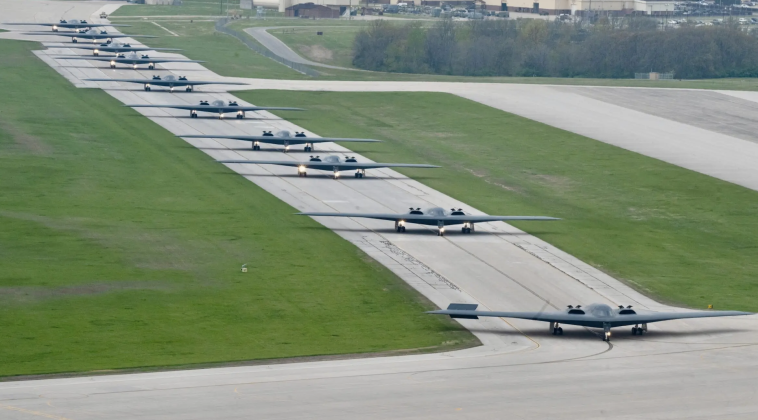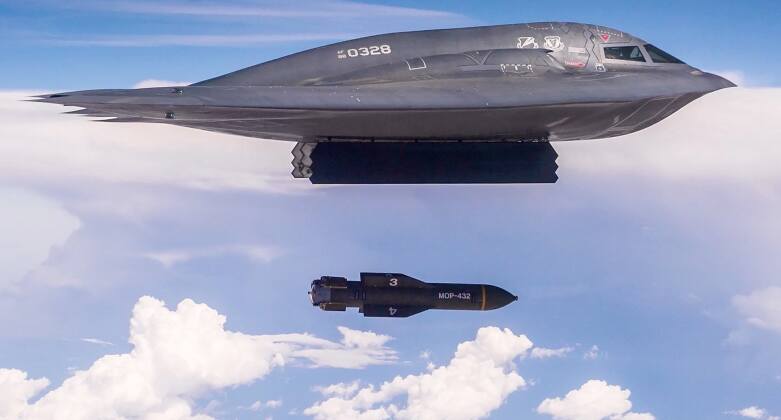The U.S. Air Force on April 15 deployed 12 B-2 Spirit intercontinental range stealth bombers for a major show of force, with 12 of the service’s small fleet of just 20 aircraft taking part in a large fly-off exercise at Whiteman Air Force Base, Missouri. The B-2 has notoriously high maintenance needs that far exceed those of any other combat jet in the world, and availability rates that are particularly low within the American bomber fleet, which makes the deployment of 12 of the aircraft – or 60 percent of the fleet – an exceptional show of force. Two aircraft, representing a further 10 percent of the fleet, are currently being repaired after being damaged in separate landing incidents, with the remaining six likely also currently not being flight worthy. Deployed under the Spirit Vigilance exercise, the fly off came just a day after Iran launched multiple waves of cruise missile, ballistic missile and drone attacks on military facilities in Israel on April 13-14, retaliating for an Israeli air strike on an Iranian diplomatic building in Syria on April 1. This raised the possibility of escalated hostilities between Iranian and both U.S. and Israeli forces, with the latter expected to be supported by a number of other Western states. It remains uncertain to what extent recent hostilities influenced the decision to conduct the B-2 flyoff, with the state of the fleet meaning it likely required at least several days of preparations to stage.

The B-2 bomber is considered a particularly critical asset for any major Western attack on Iran, as it is the sole aircraft capable of delivering GBU-57 ‘bunker buster’ bombs which have the greatest penetrative capacity of any non-nuclear weapons. This is vital as Iranian military bases, including missile storage facilities and even airfields, have been deeply fortified underground. Since the U.S. withdrawal from the Joint Comprehensive Plan of Action nuclear deal in 2018, the possibility of American-led attacks on Iranian nuclear facilities, many of which have also been deeply fortified underground with North Korean assistance, has also been raised. The B-2’s stealth capabilities and tremendous weapons carrying capacity make it the only viable delivery platform for the 15,000 kilogram bombs, which have been in service since 2010. While the bombers’ special maintenance requirements mean they cannot be based outside the United States, the aircraft have been deployed for operations across the world from American bases, including for bombing of Iran’s neighbour Iraq in 2003. Such combat missions have at times lasted for over 24 hours. This capability is particularly valuable since American bases across the Middle East and Eastern Europe will be vulnerable to Iranian missile strikes in the event of a major war. The vulnerability of the B-2 fleet to disruptions at airfields was demonstrated when the Air Force’s sole unit, 509th Bomb Wing, was left out of service for half a year by an accident in December 2022.

The viability of the B-2 for strikes on Iranian targets remains in question today, as while the aircraft’s stealth capabilities were cutting edge in the 1990s, advances in radar technologies over the past three decades have left them increasingly at risk. Indeed, the potency of Soviet air defences as early as the 1980s resulted in costly modifications being made to the B-2’s design preceding its production to allow for low altitude penetration of enemy airspace. It is thus expected that the B-2 will not be deployed unless local air defences are thoroughly suppressed, which remains challenging due to the high density and considerable sophistication of the Iranian air defence network. Iran’s air defences have continued to be modernised with acquisition of assets such as Russian Rezonans-NE radar systems optimised for detecting stealth aircraft, as well as missile systems such as the Khordad-15 and Bavar 373 with long range targeting capabilities.
Iranian situational awareness against potential aerial threats is set to be further enhanced over the following year with the delivery of Russian Su-35 fighter aircraft, which were designed specifically to counter stealth aircraft through the use of triple radars operating in complementary wavebands, infrared tracking systems, and data links to integrate with ground based radars. The U.S. Air Force is itself set to modernise its intercontinental range strike capabilities with the replacement of its B-2 and B-1B bombers with the B-21 Raider – a next generation stealth bomber that made its much delayed first flight in November 2023 and is expected to enter service before 2030.
